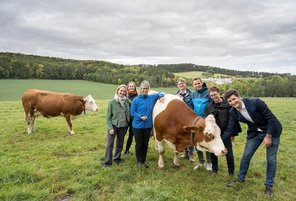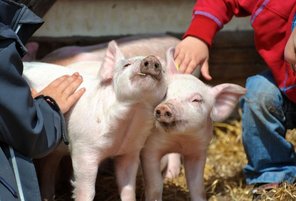- animal-welfare-science /
- Infoservice
2025
Janja Sirovnik Koscica studied veterinary medicine at the University of Ljubljana in Slovenia. This was followed by PhD studies in Biomedical Sciences at the University of Bern, Switzerland. In her dissertation, Janja Sirovnik Koscica focused on the effects of feeding positioning and the feeding place on the behavior of laying hens, the distribution between feeding places as well as health and productivity. Sirovnik Koscica also looked at the benefits of portable digital radiography for assessing sternum damage in poultry.
Janja Sirovnik Koscica worked as a postdoc at Justus Liebig University in Giessen before moving to the Center for Animal Nutrition and Animal Welfare Sciences at Vetmeduni in 2020.
Her current research interests include telomere dynamics as an indicator of cumulative life experience in farm animals, automatic recognition of behavior and emotions in chickens, and risk factors and solutions for sternum fractures on Austrian farms.
Sirovnik Koscica heads the Poultry Department at the Center for Animal Nutrition and Animal Welfare Sciences at the Vetmeduni and was appointed Assistant Professor on 1 February 2025. In future, she will supplement the research and teaching focus on sustainability and animal welfare in livestock and expand it further in order to consolidate scientific evidence for the further development of livestock science.
Janja Sirovnik Koscica is a member of the Committee for Animal Husbandry and Animal Welfare of the Austrian Society of Veterinarians (ÖGT-TuT) and President of the World Poultry Science Association - Austria (WPSA-AT).
As an assistant professor of animal welfare science in livestock, Borbala Foris is driving forward research at the intersection of positive social behavior and automated measurement methods in order to make behavioral changes usable as indicators. Born in Hungary, she focuses primarily on precision livestock farming (PLF).
Zur Presseinformation - in German
Scientists from BOKU and Vetmeduni have developed a WhatsApp crime game that sheds light on the interrelationships of the animal food supply and shows how each individual's consumption decisions influence it. Exciting, educational and with a clear focus on sustainability.
Zur Presseinformation - in German
International Team Establishes First Definition of Positive Animal Welfare
An interdisciplinary team of scientists from 23 institutions across 15 countries has proposed a long-awaited definition of Positive Animal Welfare (‘PAW’). For decades, animal welfare science has largely focused on minimizing suffering. This pioneering paper breaks new ground by highlighting the importance of positive experiences and positive states for animals. The consensus reached by the team defines positive animal welfare as the animal flourishing through the experience of predominantly positive mental states and the development of competence and resilience. This novel definition lays the foundation for a richer, more comprehensive understanding of animal welfare. This effort is part of a European project called ‘LIFT, lifting farm animal lives’, funded by COST and regrouping over 330 scientists.
According to lead author Prof. Jean-Loup Rault from the University of Veterinary Medicine in Vienna, "Positive Animal Welfare goes beyond good physical health and the alleviation of suffering. It is about promoting the ability of animals to flourish through rewarding experiences, choice, and the active pursuit of goals". It offers a different perspective on animal welfare and set higher standards. Providing positive welfare to animals could be encouraged by, for example, providing enough space for calves to play, as play can be deeply rewarding. Similarly, pigs housed with plenty of straw are more satisfied, as their natural motivation to explore is fulfilled.
This groundbreaking definition is expected to drive innovative research and better align animal care practices with societal expectations on how to keep and care for animals. As co-author Prof. Margit Bak Jensen notes, "This definition represents an important step towards a substantial improvement for the welfare of animals across farms, homes, and zoos." In short, the future of animal welfare has arrived, and it’s aiming for a good life.
Rault J-L et al. 2025 A consensus on the definition of positive animal welfare. Biology Letters 21: 20240382
Scientific contact
Univ.-Prof. Jean-Loup Rault PhD E-Mail
2024
Lassen sich Nachhaltigkeit und Tierwohl unter einen Hut bringen? Wie sieht eine nachhaltige Landwirtschaft aus, die zugleich auf das Wohl der Tiere achtet? Und was bedeutet das für die Tiere, die Landwirte und am Ende für uns Konsument:innen? Wie kann man Nachhaltigkeit und Tierwohl messen und bewerten? Lässt sich beides angesichts des steigenden Preisdrucks überhaupt vereinbaren – vor allem auch für kleine Betriebe?
Mehr Info zum aktuellen VetmedTalk
Jetzt Aufzeichnung ansehen! VetmedTalk
2023
At the ITT, we strive to strengthen our collegiality and the "team spirit" with joint activities (on a voluntary basis) and so -several times a year- we go on trips, visit Christmas markets or museums or have a BBQ-afternoon.
In June 2023 we visited the parrot station of the ARGE, which new location was opened in 2022, in the 9th district of Vienna. The association, founded in 1995, runs a donation-financed sanctuary for unwanted parrots, e.g. birds, that have been confiscated by the authorities. The parrot protection center is run as an approved animal shelter and is under scientific management. The stock now has a size of about 180 animals, ranging from budgerigars to macaws. The sanctuary is run according to the principles of zoological parrot husbandry, i.e. the birds are kept in compatible groups in well-structured flight enclosures. The association also offers support and advice on finding a partner for lonely single parrots and is a nationally unique and internationally recognized contact point for questions about the species-appropriate keeping of exotic birds.
We would like to congratulate the association on this successful project of the new protection center, like to say thank you for the interesting tour and are pleased to announce that we were able to initiate a future internship cooperation for prospective veterinarians. (Contact via secretariat if interested)
Elsevier is a scientific publisher of scientific journals and specialist literature. The core business of the publishing house includes scientific, technical and medical publications. Elsevier publishes around 3,500 scientific journals and 2,200 books annually.
The journal "Applied Animal Behavior Science" publishes relevant information on the behavior of pets and livestock. This journal has an Impact Factor of 2,448, ranking it 33rd out of 146 in the Veterinary Sciences category. Because this journal is indexed in 12 international databases, a published article can be read and cited by researchers worldwide.
We are pleased that three of our publications can currently be found on the list of the most downloaded articles from "Applied Animal Behavior Science" in the last 90 days:
- Chewing behavior in dogs – A survey-based exploratory study [Christine Arhant, Rebecca Winkelmann, Josef Troxler]
- Relationships between owner and household characteristics and enrichment and cat behavior [Ines Wind Schnurer, Andrea Häusler, Susanne Waiblinger, Grahame J. Coleman]
- Assessing the human–animal relationship in farmed species: A critical review [Susanne Waiblinger, Xavier Boivin and 5 more]
The documentation and information center, based at the ITT, headed by Mrs. Hofrätin DDr Binder, has published the following:
Enrichment cats:
Possibilities to improve the quality of life of experimental cats through enrichment measures - an overview; Vienna Veterinary Monthly (WTM) 2022(109).
The article summarizes the current state of research on strategies for enrichment in the keeping of (experimental) cats recommended in the specialist literature.
Muzzles:
Muzzles as a means of bite prevention - history, muzzle requirement, animal welfare and safety aspects; Vienna Veterinary Monthly (WTM) 2023(110).
Based on a survey of dog trainers, the article examines injuries caused by muzzled dogs. He investigates whether certain types of muzzles that are frequently used are actually as safe as is often assumed.




